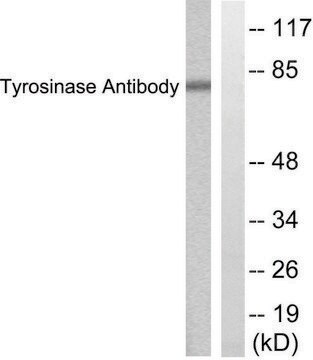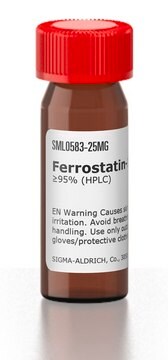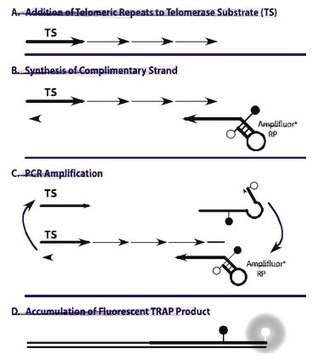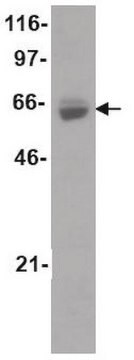05-647
Anti-Tyrosinase Antibody, clone T311
clone T311, Upstate®, from mouse
Synonym(s):
Anti-Anti-ATN, Anti-Anti-CMM8, Anti-Anti-OCA1, Anti-Anti-OCA1A, Anti-Anti-OCAIA, Anti-Anti-SHEP3
Sign Into View Organizational & Contract Pricing
Select a Size
All Photos(1)
Select a Size
Change View
About This Item
UNSPSC Code:
12352203
eCl@ss:
32160702
NACRES:
NA.41
Recommended Products
Specificity
Tyrosinase
Immunogen
Purified recombinant Tyrosinase corresponding to residues 5-456 of human Tyrosinase
Application
Not recommended for Immunoprecipitation
Research Category
Neuroscience
Neuroscience
Research Sub Category
Neurofilament & Neuron Metabolism
Neuronal & Glial Markers
Neurofilament & Neuron Metabolism
Neuronal & Glial Markers
This Anti-Tyrosinase Antibody, clone T311 is validated for use in WB, IH for the detection of Tyrosinase.
Quality
routinely evaluated by immunoblot on RIPA lysates from SK-MEL-19 cells
Target description
70-80kDa
Physical form
0.1M Tris-glycine, pH 7.4, 0.15M NaCl, 0.05% sodium azide before the addition of glycerol to 30%
Format: Purified
Protein G Chromatography
Storage and Stability
2 years at -20°C
Legal Information
UPSTATE is a registered trademark of Merck KGaA, Darmstadt, Germany
Disclaimer
Unless otherwise stated in our catalog or other company documentation accompanying the product(s), our products are intended for research use only and are not to be used for any other purpose, which includes but is not limited to, unauthorized commercial uses, in vitro diagnostic uses, ex vivo or in vivo therapeutic uses or any type of consumption or application to humans or animals.
Not finding the right product?
Try our Product Selector Tool.
Storage Class Code
10 - Combustible liquids
WGK
WGK 1
Certificates of Analysis (COA)
Search for Certificates of Analysis (COA) by entering the products Lot/Batch Number. Lot and Batch Numbers can be found on a product’s label following the words ‘Lot’ or ‘Batch’.
Already Own This Product?
Find documentation for the products that you have recently purchased in the Document Library.
Structure-toxicity relationship of phenolic analogs as anti-melanoma agents: an enzyme directed prodrug approach.
Vad NM, Kandala PK, Srivastava SK, Moridani MY
Chemico-Biological Interactions null
Efficacy of acetaminophen in skin B16-F0 melanoma tumor-bearing C57BL/6 mice.
Nikhil M Vad,Shashi K Kudugunti,Daniel Graber,Nathan Bailey,Kalkunte Srivenugopal,Majid Y Moridani
International journal of oncology null
Hee-Sun Lim et al.
Chonnam medical journal, 52(1), 45-52 (2016-02-13)
As a key regulator of melanogenesis, p53 controls microphthalmia-associated transcription factor (MITF) and tyrosinase expression. The anti-oxidant enzyme heme oxygenase-1 (HO-1) is induced by various forms of cellular stress and diverse oxidative stimuli. However, few studies have examined the role
Y T Chen et al.
Proceedings of the National Academy of Sciences of the United States of America, 92(18), 8125-8129 (1995-08-29)
Tyrosinase (EC 1.14.18.1), the key enzyme in melanin synthesis, has been shown to be one of the targets for cytotoxic T-cell recognition in melanoma patients. To develop serological reagents useful for immunophenotyping melanoma for tyrosinase, human tyrosinase cDNA was expressed
Shashi K Kudugunti et al.
Chemico-biological interactions, 188(1), 1-14 (2010-08-06)
In the current work, we investigated the in vitro biochemical mechanism of Caffeic Acid Phenylethyl Ester (CAPE) toxicity and eight hydroxycinnamic/caffeic acid derivatives in vitro, using tyrosinase enzyme as a molecular target in human SK-MEL-28 melanoma cells. Enzymatic reaction models
Our team of scientists has experience in all areas of research including Life Science, Material Science, Chemical Synthesis, Chromatography, Analytical and many others.
Contact Technical Service







